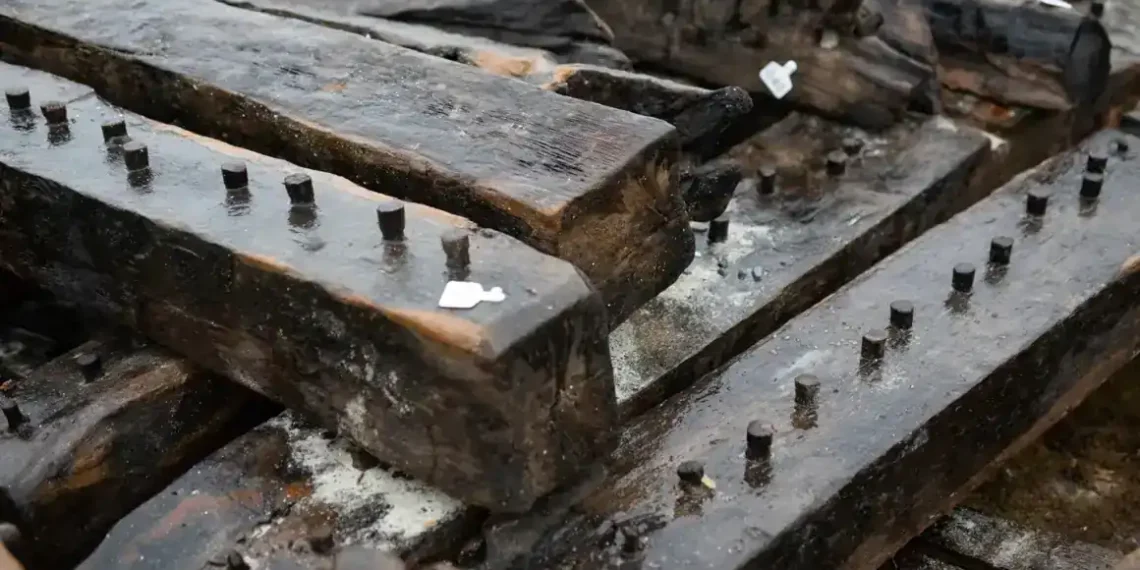Schoolboy’s discovery leads to identification of 18th-century warship wreck in Orkney
July 23, 2025 – 4:30 PM
When a boy spotted wooden beams sticking out of a beach on a remote Scottish island, it kicked off a year-long investigation involving archaeologists, scientists, and dedicated locals. Their efforts just revealed that the remains likely belong to the Earl of Chatham — a British warship that served in major battles before its final days as a whaler in the Arctic.
Here’s how this remarkable discovery came together — and why it matters today.
A historic ship uncovered after a storm
In February 2024, a strong storm hit Sanday, one of the Orkney Islands in northern Scotland. The high winds and heavy surf stripped away layers of sand from a beach, revealing the skeletal remains of an old wooden ship.
A schoolboy out for a run spotted the exposed ribs of the vessel. His sighting sparked immediate interest among the island’s 500 residents — many of whom have deep connections to the sea and its long, sometimes tragic, history.
Ben Saunders, a senior marine archaeologist with Wessex Archaeology, called the find “lucky.” Not just because it survived, but because it happened on an island with a strong sense of community and history.
“I think if it had been found in many other places, it wouldn’t necessarily have had that community drive, that desire to recover and study that material,” Saunders said.
Local effort brings the wreck ashore
As news of the ship spread, local farmers jumped in to help. Using tractors and trailers, they hauled 12 tons of oak timbers from the beach to the Sanday Heritage Centre.
“That was really good fun,” said Sylvia Thorne, one of the island’s volunteer researchers. “It was such a good feeling — everybody pulling together to get it back. Quite a few people are getting interested and becoming experts.”
The oak timbers were preserved in a freshwater tank while researchers worked to determine the ship’s identity.
Tree rings tell the story
Scientists used dendrochronology — the study of tree rings — to date the ship’s timber. The wood matched trees from southern England, felled in the mid-1700s. That timing lined up with Britain’s detailed naval records, which had just begun keeping careful logs of shipbuilding and wrecks.
Saunders explained how the team narrowed it down:
“You remove ones that are Northern European as opposed to British, you remove wrecks that are too small or operating out of the north of England, and you really are down to two or three… and Earl of Chatham is the last one left.”
From warship to whaler
Records show the ship was originally named HMS Hind, a 24-gun Royal Navy frigate built in Chichester in 1749.
It played a key role in British imperial battles. In the 1750s, it helped take Canada from France during the sieges of Louisbourg and Quebec. Later, it escorted supply ships during Britain’s losing effort to keep control of its American colonies in the 1770s.
After the war, the navy sold the ship in 1784. Renamed Earl of Chatham, it began a second career — as a whaling ship in the icy waters off Greenland.
Whale oil was a major resource in the 18th century, used for lighting, lubricating machines, and processing fabric during the Industrial Revolution.
In 1787, records list Earl of Chatham among 120 London-based whalers headed for the Greenland Sea.
A year later, disaster struck. A storm wrecked the ship off the coast of Sanday — but all 56 crew members survived.
That’s just one reason Saunders calls it a “lucky ship.”
Connecting past and present
The wreck’s discovery has energized Sanday’s small community, drawing attention to the island’s rich maritime past.
There have been nearly 270 recorded shipwrecks around Sanday since the 15th century, making it a hotspot for naval history and underwater archaeology.
For Ruth Peace, another community researcher, the find made that history feel real.
“One of the biggest things I’ve got out of this project is realizing how much the past in Sanday is just constantly with you — either visible or just under the surface,” she said.
The effort is also a model for how local communities can take the lead in preserving and understanding their history.
“The community have been so desirous to be involved,” said Saunders. “It’s down to them it was discovered, it’s down to them it was recovered and protected.”
What’s next for the Earl of Chatham
The recovered ship timbers are still soaking in freshwater to prevent decay. Long-term plans are underway to create a public display at the Sanday Heritage Centre.
Meanwhile, researchers say this type of discovery may become more common. As climate change alters coastlines and uncovers new layers of land and sea, long-hidden artifacts like the Earl of Chatham could resurface.
A living reminder of history
This story began with a boy’s walk on the beach and led to the identification of a vessel that once sailed into war, hunted whales, and weathered countless storms.
Now, thanks to teamwork between experts and locals, the Earl of Chatham is teaching us more about the world it sailed — and the one we live in today.
Have a story from the past your community uncovered? Share it with us.
This article was rewritten by JournosNews.com based on verified reporting from trusted sources. The content has been independently reviewed, fact-checked, and edited for accuracy, neutrality, tone, and global readability in accordance with Google News and AdSense standards.
All opinions, quotes, or statements from contributors, experts, or sourced organizations do not necessarily reflect the views of JournosNews.com. JournosNews.com maintains full editorial independence from any external funders, sponsors, or organizations.
Stay informed with JournosNews.com — your trusted source for verified global reporting and in-depth analysis. Follow us on Google News, BlueSky, and X for real-time updates.














